Answer these simple questions and we will find you the BEST prices
Which type of solar quotes do you need?
It only takes 30 seconds
100% free with no obligation

Get Free quotes from insulation specialists near you

Save money by comparing quotes and choosing the most competitive offer

The service is 100% free and with no obligation
- GreenMatch
- Insulation
- Cladding Insulation
Cladding Insulation: Your Complete UK Guide

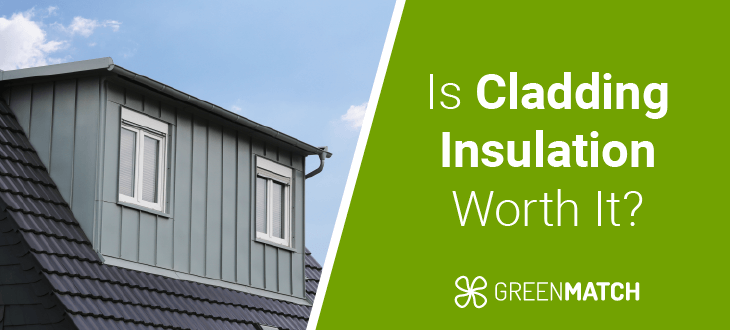
- Cladding insulation helps further enhance your home’s ability to retain heat.
- A typical cladding insulation costs around £80 - £100 per m2.
- There are plenty of materials and aesthetic options to choose from.
Uninsulated walls are responsible for a staggering one-third of home heat loss, more than any other home area that can be insulated. This leads to sky-high energy bills and a staggering domestic carbon footprint for your household.
Luckily, homes with solid walls can fit exterior cladding material onto their outer walls to retain heat and reduce noise pollution, making it a cost-effective and straightforward boost to your home's energy efficiency.
Better yet, cladding comes in all sorts of materials, designs, and aesthetics suitable for all budgets and tastes. It’ll leave your home looking better than ever while increasing your savings and home sustainability!
This complete GreenMatch UK guide will give you all you need to know regarding home cladding insulation, including the best materials, benefits, drawbacks, and what to expect.
Ready to get some wall cladding? Let GreenMatch UK be your one-stop solution for all your needs. Instead of spending endless hours researching and vetting installers online, just spend 30 seconds filling out our simple form, and we’ll send you up to 3 free home-tailored quotes from our trusted network of installers in your area. Click below to begin!
- Describe your needs
- Get free quotes
- Choose the best offer
It only takes 30 seconds



What is cladding insulation?
Cladding insulation is the external protective layer of material that coats the structure of your home. While many homes may have simple brick facades, you might notice some homes with prefabricated panels or boards along exterior walls. This is external wall insulation cladding.
In most cases, homes will have external wall insulation cladding to protect the wall insulation behind the cladding from weathering and damage. Cladding also enhances your existing insulation, improving your home's carbon footprint.
Cladding insulation installation process
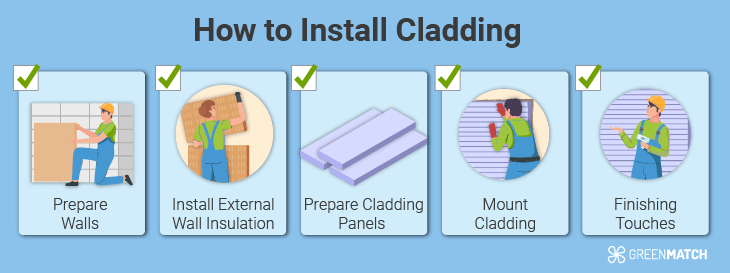
Cladding insulation installation is relatively straightforward and non-invasive to your home environment. Since the entire installation process takes place outside of your home, your interior remains peaceful and undisturbed.
Here is what to expect with the process of cladding installation:
- Prepare walls: Before installing cladding, an installer should assess your walls and make sure existing damage or issues are solved in advance. This includes levelling cracks and bumps, and cleaning the wall from dust and debris.
- Install external wall insulation: Once the walls are prepared, you can install external insulation. This is normally done by fixing rigid insulation boards (like PIR) to your external walls, and then adding the cladding material. If you have internal wall insulation, this step is not required.
- Prepare cladding panels: Next up, an installer will take measurements of your walls and cut the external insulation cladding boards accordingly. Cladding material can be purchased in standard sizes and easily cut with a jigsaw or circular saw.
- Mount cladding: To mount cladding, an installer will screw a starter strip into place on your wall. This helps create enough space for the rest of the external insulation cladding boards to sit comfortably.
- Finishing touches: Once the cladding is in place, a final inspection is done to identify gaps and fill them with silicone sealing. This helps prevent moisture buildup and weathering that can damage the wall and insulation underneath. You can also make final aesthetic touches in this stage, such as painting your cladding.
To make sure you get the most effective insulation, it’s important to work with a professional installer. Faulty jobs and poor workmanship could soon lead to unnecessary repair costs and home damage.
What is the best cladding for insulation?
The best cladding for insulation depends on your specific needs and home conditions. These factors include your home size, wall type, budget, and even aesthetic tastes.
Nevertheless, there are plenty of cladding options on the market suited for every budget and taste. This section will summarise some of the most popular cladding insulation materials available, as well as their pros, cons, and estimated pricing.
Wood cladding

Wood or timber cladding - costing around £10 - £90 per m2 - is made naturally from farmed timber and has an appealing rustic look that homeowners enjoy. Alongside its elegance and affordability, timber is a structurally sound and reliable material that - if treated properly - will bring your home comfort for years to come.
- Sustainably farmed timber is one of the most environmentally friendly options available for home cladding.
- Easily recyclable and does not pose a pollution risk.
- Aesthetically pleasing, giving your home a beautiful elegant rustic look.
- High maintenance needs, requiring annual treatment to keep it looking fresh and free from the risk of rot and mould.
- Some high-quality woods can cost more than £100. Additionally, not all wood is suitable for the job and often needs treatment and frequent maintenance.
- May pose a fire risk to your property if not treated properly.
Fibre cement cladding
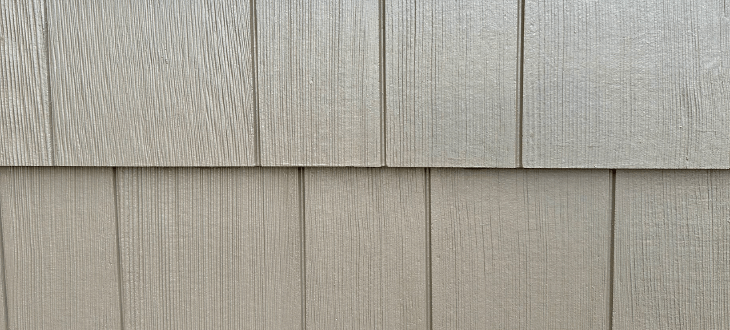
Fibre cement cladding - costing around £60 - £150 per m2 - is made from a combination of sand, cement, cellulose and water, making it one of the more sustainable and affordable cladding material options on the market.
It comes with hardly any maintenance needs, is very durable, and gives your home a high-quality finish with a slight wood-like texture.
- One of the cheapest options on the market, making it easy to afford for most budget types.
- Highly durable and naturally fire-resistant.
- A sustainable material, usually made from recyclables, can easily be recycled at the end of its lifespan.
- Absorbs moisture more than other cladding materials, creating a bigger risk of wet spots and mould forming.
- Not as effective at retaining heat compared to other materials.
- Despite the use of cement, it can come at risk of rot and termite infestations.
Composite cladding
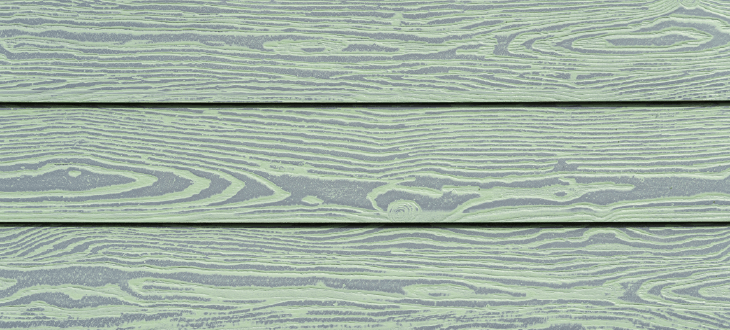
Composite cladding - costing around £40 - £45 per m2 - is made from a combination of wood and plastics, making it a durable, yet adaptable exterior insulation cladding material for any household. Composite cladding is usually made from recycled materials and is a relatively sustainable option.
- A very low-maintenance material which requires no sanding, varnishing, or painting.
- Often made using recycled timber and plastics, helping reduce waste pollution.
- Weatherproof and resilient to moisture and harsh conditions.
- On the more expensive side, costing higher than uPVC and timber cladding.
- Cannot be repainted and refinished once you decide on a design and aesthetic.
- Will require occasional cleaning.
uPVC cladding
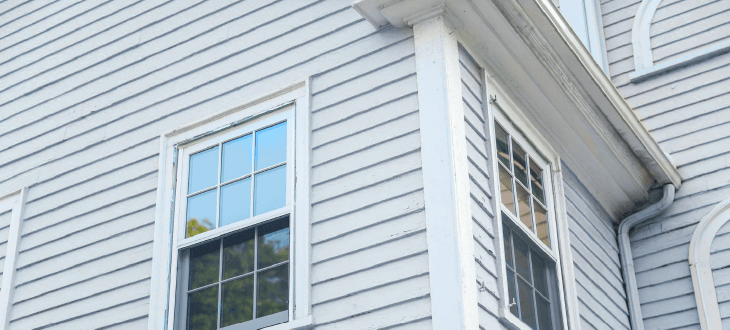
uPVC or cladding - also called vinyl cladding - is one of the most affordable exterior insulation cladding options on the market. Costing around £30 - £60 per m2, uPVC is exceptionally durable, resistant to weathering, and easy to install.
Most of these insulated cladding sheets also come with a strip of foam insulation pre-fixed to the back for enhanced heat retention. While not typically used for domestic properties, uPVC has started to become a popular choice due to its affordability.
- One of the most affordable cladding materials on the market.
- Very lightweight, easy to shape, and install.
- Fire resistant, mould resistant, and requires little to no upkeep.
- A very unrecyclable material, making it very difficult to dispose of sustainably.
- Up close, uPVC cladding can look very cheap and aesthetically unpleasing.
- Prone to sun damage, making your cladding brittle and easy to break.
Stone cladding

Stone cladding is made from thin layers of refined (natural or artificial) stone. It costs around £30 - £50 per m2 for artificial stone, while natural stone could be as high as £100 per m2 due to the expertise needed by a stonemason to craft each stone for your property meticulously.
- One of the most aesthetically pleasing options on the market.
- Great for homes facing harsh weather due to its natural ability to resist dampness.
- Extremely durable, fire resistant, and virtually needs no maintenance.
- Has one of the highest upfront material and labour costs of all cladding materials.
- Comes from quarrying, which is an environmentally disruptive and generally unsustainable practice.
- Heavier material weight means stone cladding is tougher to transport, and requires a very structurally sound home to apply it to.
Brick cladding

Brick cladding - also known as brick slip cladding - is made by cutting standard bricks into slips of 14 to 20mm which are then fitted as exterior insulation cladding on the outer walls of your home. Costing around £35 - £100 per m2, this attractive traditional brick look is widely desired by households.
- A cost-effective option with budget-friendly variations.
- Low maintenance, fire resistant, and durable to weathering.
- An aesthetically pleasing option that recreates a red brick look for a fraction of the cost.
- Can cost more than material options like uPVC or wood cladding.
- Fewer design options are available for brick cladding, as most are standard red bricks.
- More prone to moisture ingress from freeze-thaw damage from summer to winter.
Metal cladding

While more commonly used in commercial and agricultural properties, metal cladding has seen a recent uptick in popularity for domestic homes too.
Zinc cladding is a popular choice that is steadily dethroning the more commonly used aluminium and steel due to its affordability, malleability, and durability, costing around £35 - £120 per m2.
- A long lifespan of over 50 years, and is fully recyclable, making it a sustainable choice.
- Exhibits self-healing properties against scratches and abrasions as the zinc weathers.
- Corrosion, rust, and moisture resistant, but at a more affordable price than other metals.
- Prone to colour changes, requiring a paint job from time to time.
- Zinc will oxidise. While some homes enjoy this look, others may find it unappealing.
Cost of external cladding insulation
The average cost of external cladding insulation is around £80 - £100 per m2 including installation. Note that this is different from the cost of wall insulation. Prices are based on materials such as uPVC, composite, or fibre cement, but can fluctuate based on your chosen material and installation.
The typical labour costs offered by specialist contractors are around £150 - £200 per day, and the duration of installation will likely take 2 - 3 days for a standard semi-detached UK home.
It’s strongly suggested to work with a professional specialist for external cladding, but you might cut labour costs a little by working with labourers instead.
Skilled labourers with the right qualifications for an external cladding job can cost slightly less, at around £50 – £150 per day.
There are many factors to consider when predicting average costs for a full-cladding job. This includes your choice of cladding material, home size and shape, chosen installer, and even location, as urban jobs can cost more than rural ones.
While it’s difficult to ballpark an average cost, here’s our full breakdown of material prices per m2 to give you an idea of what to expect:
| Cladding material | Average price (per m2) |
|---|---|
| Wood (timber) | £10 - £90 |
| uPVC (vinyl) | £30 - £60 |
| Stone (artificial) | £30 - £50 |
| Brick | £35 - £100 |
| Composite | £40 - £45 |
| Metal (zinc) | £35 - £120 |
| Stone (natural) | £50 - £100 |
| Fibre cement | £60 - £150 |
Alongside material and labour costs, there are other additional costs you can expect that are part of the installation process. It’s important to clarify with your installer if these are included in their quote price or not:
- Scaffolding: Installing cladding in a multi-storey will require scaffolding in place to make the higher parts of your walls accessible. In the UK, scaffolding setup and takedown for a standard semi-detached home can cost around £1000.
- Skip hire: The process of cladding an entire home will likely create a mess of packaging, debris, and cut cladding ends. You’ll need to hire a purpose skip to dispose of this material, which can cost you anywhere from £60 - £400 depending on the size.
- Additional repairs: When installing cladding, some unresolved home issues may arise. These must be solved before cladding to ensure no risk is posed to your investment. For example, mending damaged drainage and guttering can cost an extra £250.
External wall insulation grants
In the UK, there are currently two main grant schemes offering external wall insulation for qualifying households. These are the Great British Insulation Scheme (GBIS) and the Energy Company Obligation (ECO4). Both schemes will be active until March 2026.
Each home insulation grant provides comprehensive financial assistance for insulation upgrades to fuel-poor, low-income and energy-inefficient households, they do not provide external insulation cladding grants.
Following the horrendous Grenfell Tower fire in June 2017, the UK government enacted new building safety requirements that sought the replacement of flammable building cladding. One example is the UK’s Cladding Safety Scheme (CSS), which provides funding for the replacement of potentially hazardous cladding in structures over 11m in height (e.g. flats).
You can apply for an assessment by the CSS through the official UK government website.
Is cladding insulation worth it?

Cladding is a useful insulation-enhancing technique that comes with a whole host of benefits for you and your home. Let’s take a look at some of the key benefits you could expect from insulating your home:
- Better home insulation: Alongside wall insulation measures, cladding acts as an insulation enhancer, improving both your home’s ability to retain heat, as well as protecting the insulation behind cladding (if you install external wall insulation).
- Enhanced protection: External insulation cladding insulation protects your home’s brickwork against weathering and damage in the long run, reducing the need for future maintenance.
- Improved home appearance: There is an endless sea of design options for external insulation cladding, suitable for all tastes and budgets. Utilising a wide range of materials with their perks and drawbacks, there are plenty of options for everyone to customise their home.
- Higher property value: External insulation cladding can increase the value of your property on the housing market, due to its protective qualities and insulation capacity. Therefore, investing in cladding is also investing in the future of your property.
- Cost-effective upgrade: Since there are so many options for cladding available on the market, there’s an option suited for all types of budgets.
All things considered, cladding insulation is a great option for solid wall homes looking to enhance their property protection and insulation capacity.
Compare multiple quotes on cladding insulation
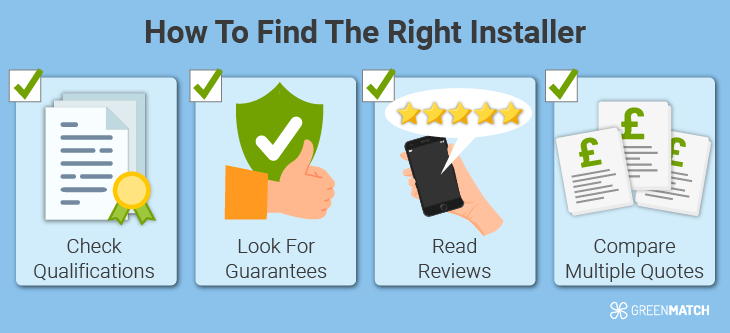
Picking your ideal cladding material is just the beginning of the road when it comes to an insulation job. It’s important to work with a professionally qualified installer to make sure the job is conducted properly. Here are some tips to research and vet your options correctly:
- Check qualifications: When contacting installers, check for existing certifications and accreditations they may have. Look out for installers accredited by the National Federation of Roofing Contractors (NFRC), or the Continued Professional Development (CPD) certificate, both of which assess contractor professionalism for cladding.
- Look for guarantees: Professional contractors and installers who have trust in their capabilities may offer warranties and guarantees on their installation job. This is often a good sign of their professionalism.
- Read reviews: Check the experiences of previous customers who worked with a contractor you consider. You can even contact previous clients directly to learn more about their experiences. This will give you a rounded idea of what to expect.
- Compare multiple quotes: Don’t just settle on the first installer that crosses your path! It’s important to compare multiple quote prices, check what each pricing scheme covers, and then pick the best bargain for your home.
Researching and vetting for the perfect installer is no easy task. One could find themselves spending countless hours scouring websites and scheduling phone calls with no bargain in sight. That’s where GreenMatch UK comes in to save the day.
Instead of enduring the headache of endless vetting, just spend 30 seconds filling out our simple online form, and we can send you up to 3 free quotes from our network of trusted installers in your area. The best part? Our services are completely free of charge and come with no obligations. Secure the best deal for your home today. Click below to begin!
- Describe your needs
- Get free quotes
- Choose the best offer
It only takes 30 seconds



FAQ
Cladding is the application of covering one material with another, almost like a skin or cover. When it comes to insulation, cladding is applied either onto existing external insulation or directly onto the walls of a property for enhanced protection and insulation.
External wall insulation is often accompanied by cladding. Insulation such as rigid boards (e.g. PIR boards) are secured onto the exterior walls of a home and then covered in plaster and cladding. This helps protect the insulation material from damage and weathering while enhancing its capability to retain heat.
The best cladding for insulation purposes is likely uPVC / vinyl cladding. These are relatively affordable and often come with a built-in layer of foam insulation on the back that helps further enhance your home’s capacity to retain heat. Additionally, uPVC is fire, mould, and moisture resistant.
Unfortunately, uPVC and vinyl cladding aren’t the most sustainable materials and are very difficult to recycle. A more environmentally conscious choice would be composite cladding, made from a combination of recycled timber and plastics, with similar properties to uPVC.
Cladding will provide your home with enhanced insulation, making it easier to retain heat, but cladding alone is not a solution for wall insulation. Uninsulated walls are responsible for over 33% of heat loss in a home, and therefore sufficient wall insulation is needed in the first place.
If you opt for external wall insulation, cladding is required to protect your insulation material against weathering and damage, while also enhancing the appearance of your property.
The average cost of insulation cladding for a home is around £80 to £100 per m2, but this price can fluctuate based on your chosen cladding material and installation complexity. In terms of installers, a professional cladding contractor will usually charge about £150 to £200 per day of work, whilst labourers will sit at a slightly lower cost.

Akif is a copywriter at GreenMatch since 2023. With a keen interest in community sustainability, green solutions and the role of digital media in identifying climate trends, he aims to hone in on his background in International Studies and Digital Media to provide a multidisciplinary approach to written content rooted in credible research and accuracy.
We strive to connect our customers with the right product and supplier. Would you like to be part of GreenMatch?

